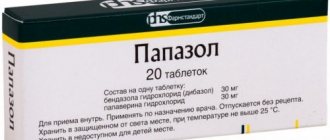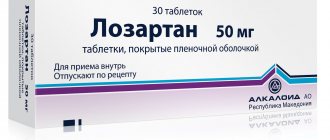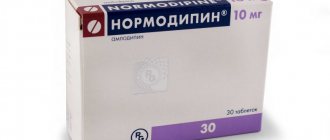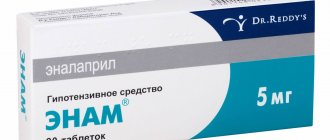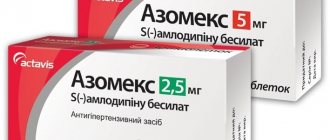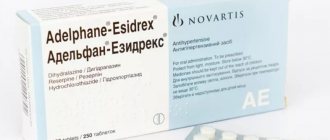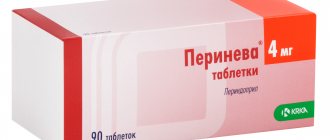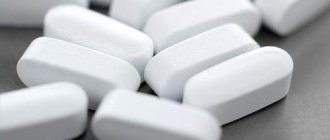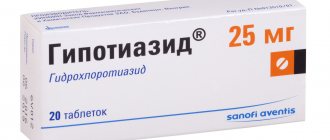Brief information about the medicine
Release forms
The drug is made in tablet form and in the form of eye drops.
White, round, film-coated tablets. The tablets are stored in the contour cells of the blister. One pack contains 10 tablets. A cardboard pack can contain from 10 to 100 tablets; the package contains instructions for using Betaxolol.
Eye drops are a translucent yellowish liquid. The drug in the form of drops is packaged in droppers of 5 - 10 ml.
Compound
The tablet contains the active substance betaxolol in a dosage of 20 mg.
Other components of Betaxolol:
- sodium carboxymethylcellulose;
- magnesium stearate;
- MCC;
- milk sugar;
- silica.
Shell components:
- polyvinyl alcohol;
- white opadray-2;
- titanium dioxide;
- talc;
- polyethylene glycol.
Betaxolol tablets
pharmachologic effect
Betaxolol tablets have a pronounced hypotensive effect.
Manufacturer
The drug is produced at the Moscow Endocrine Plant in Russia.
Terms and conditions of storage
It is recommended to store the drug in a dark place away from children at a temperature not exceeding 25 degrees.
The shelf life of the drug is 3 years from the date of production. At the end of the shelf life of the medicine, the medicine should be thrown away.
Conditions for dispensing from a pharmacy
The drug Betaxolol is sold in pharmacies without a prescription.
Price
The cost of Betaxolol tablets is 100 rubles.
Pharmacokinetics
After oral administration, more than 95% of the dose of betaxolol is rapidly absorbed from the gastrointestinal tract. Bioavailability - 80-95%. Cmax of the active substance in the blood plasma is achieved after 3-4 hours. It is subject to the “first pass” effect through the liver. Metabolized in the liver to form inactive metabolites (85%). Plasma protein binding is about 50%. Vd - about 6 l/kg. T1/2 of betaxolol is 14-22 hours. It is excreted by the kidneys (more than 80%) mainly in the form of metabolites (15% unchanged). If liver function is impaired, T1/2 is prolonged by 33% (no dose adjustment required); in case of impaired renal function T1/2 - 2 times (dose reduction required), in elderly patients it is 30 hours. Passes through the blood-brain barrier, the placental barrier, and penetrates into mother's milk.
Pharmacodynamics: how it affects blood pressure
The drug belongs to the pharmacological group of beta-blockers. The tablets do not have sympathomimetic activity and have a weak membrane-stabilizing effect.
Betaxolol lowers blood pressure, reduces peripheral vascular resistance, and reduces the minute volume of circulating blood.
Tablets with a prolonged effect do not retain sodium in the body, do not affect the activity of beta-agonists, and do not interfere with glucose metabolism.
The drug acts as a beta-blocker
Pharmacological properties of the drug Betaxolol
betaxolol (( RS )-l-[4-[2-(cyclopropylmethoxy)ethyl]phenoxy]-3-[(1-methylethyl)amino]-2-propan-2-ol) is a selective β1-adrenergic receptor blocker. Due to the cardioselective β-adrenergic blocking effect, it causes a decrease in blood pressure, a decrease in heart rate and a decrease in oxygen consumption by the myocardium. These effects are accompanied by weak negative inotropic and dromotropic effects. At recommended doses, betaxolol does not exhibit partial agonist activity (that is, it does not have BCA) and a membrane-stabilizing effect. Betaxolol reduces serum renin and aldosterone levels. Quickly and completely absorbed after oral administration. The effect of the first passage through the liver is insignificant, bioavailability is about 85%. Approximately 50% of betaxolol binds to plasma proteins. The volume of distribution is approximately 6 l/kg. In the body, betaxolol is mainly converted into inactive metabolites and only 10–15% is excreted unchanged in the urine. The half-life is 15–20 hours. When betaxolol solution is instilled into the eye, increased intraocular pressure is reduced by reducing the production of intraocular fluid. Betaxolol has high lipophilicity, which creates high concentrations of the drug in the tissues of the eye. It begins to act within 30 minutes, and the maximum effect is usually achieved 2 hours after topical application. The duration of reduction in intraocular pressure after a single use is 12 hours.
When use is contraindicated
Contraindications to the use of Betaxolol for blood pressure:
- decompensated and acute heart failure;
- cardiogenic shock;
- variant angina;
- 2nd and 3rd degree AV block;
- severe form of chronic obstructive pulmonary disease;
- bronchial asthma;
- disturbances of local blood flow;
- sinus rhythm disturbances with low heart rates;
- disturbance of conduction from the sinoatrial node to the atria;
- sick sinus syndrome;
- anaphylaxis;
- intolerance to the components of the drug;
- children under 18 years of age;
- simultaneous treatment with Floctafenine and Sultopride;
- increase in heart size;
- disturbed acid-base balance;
- pheochromocytoma;
- obliterating atherosclerosis of peripheral vessels;
- Raynaud's syndrome in severe form;
- low blood pressure;
- undergoing therapy with monoamine oxidase inhibitors.
For bronchial asthma, Betaxolol is contraindicated
pharmachologic effect
A cardioselective beta-1 adrenergic blocker without intrinsic sympathomimetic activity, it has insignificant membrane-stabilizing activity (in high doses). Reduces the sensitivity of peripheral tissues to catecholamines, inhibits central sympathetic impulses, suppresses renin secretion. It has a hypotensive effect associated with a decrease in cardiac output and a decrease in sympathetic stimulation of peripheral vessels, preventing an increase. Reduces heart rate, reduces contractility and myocardial oxygen demand (antianginal effect), inhibits the automaticity of the sinoatrial node and the occurrence of ectopic foci in the atria and junction. Effective antihypertensive therapy is accompanied by a decrease in the mass of the left ventricular myocardium and an improvement in a number of indicators of its contractility. Prevents increases in response to physical activity or stress. It has negative chronotropic, inotropic, dromotropic and bathmotropic effects. Effectively reduces blood pressure in patients with mild and moderate hypertension. When used in therapeutic doses, betaxolol does not inhibit cardiac activity, does not affect the metabolism of glucose and lipids, does not reduce HDL levels, does not reduce the bronchodilator effect of beta-adrenergic agonists, and does not cause sodium ion retention in the body (does not reduce excretion). When applied topically in the form of eye drops, it lowers intraocular pressure (both normal and elevated) by reducing the production of intraocular fluid. The resorptive effect is minimally expressed.
Instructions for use and dosage
The drug is available in the form of blood pressure tablets and eye drops.
Tablet form
Doctors recommend taking Betaxolol for high blood pressure once a day, 20 mg. If the patient is on hemodialysis or peritoneal dialysis, the initial dose should not exceed 10 mg per day. The time of taking the drug is selected taking into account dialysis sessions.
Eye drops
The drug is prescribed twice a day, 1 drop. In the first month of therapy, it is necessary to monitor the pressure in the eyes.
Side effects of the drug Betaxolol
Asthenia, cold extremities, bradycardia (sometimes severe), abdominal pain, nausea, vomiting, impotence, dizziness, headache, insomnia, rarely - slowing of AV conduction or progression of existing AV blockade, heart failure, arterial hypotension, bronchospasm, hypoglycemia , Raynaud's syndrome, increased intermittent claudication, skin reactions, including psoriasis-like rashes or exacerbation of psoriasis, depression. In rare cases, the appearance of antinuclear antibodies is observed, which in exceptional cases is accompanied by clinical manifestations such as systemic lupus erythematosus, which disappear after discontinuation of betaxolol. Local reactions when using eye drops: immediately after instillation, short-term discomfort in the eyes is possible. Sometimes - punctate keratitis, photophobia, lacrimation, itching, dry eyes, eye pain, decreased visual acuity, allergic reactions, decreased sensitivity of the cornea, edema and anisocoria.
special instructions
Patients with chronic obstructive pulmonary disease and bronchial asthma should use Betaxolol for high blood pressure in minimal dosages. During the course of treatment, it is recommended to constantly monitor respiratory indicators.
In case of respiratory problems or attacks, you must take beta-agonists prescribed by your doctor.
In patients with angina pectoris and cardiac ischemia, the drug should be discontinued gradually, as a withdrawal reaction is possible.
Application
Indications
Pills
: arterial hypertension;
angina pectoris; akathisia caused by neuroleptics. Eye drops
: open-angle glaucoma, intraocular hypertension, condition after laser trabeculoplasty, long-term antihypertensive therapy after ophthalmological surgery.
Contraindications
Hypersensitivity, sinus bradycardia (less than 45-50 beats/min), sick sinus syndrome, AV block II-III degree, arterial hypotension (SBP below 100 mm Hg), cardiogenic shock, acute and refractory to treatment severe heart disease failure, severe obstructive respiratory failure.
special instructions
Use during pregnancy is possible only in cases where the expected benefit to the mother outweighs the possible risk to the fetus or child. Breastfeeding should be stopped during treatment. Experimental studies have not revealed the teratogenic effect of betaxolol. However, clinical data on the effectiveness and safety of Betaxolol in pregnant women are limited.[1] During treatment, laboratory test results may change (false-positive reaction during a doping test, increase in the titer of antinuclear antibodies, etc.).
Carefully
Chronic obstructive pulmonary diseases, unstable angina, tendency to bradycardia, AV block of the first degree, impaired peripheral circulation, diabetes mellitus in the stage of decompensation, hypoglycemia, pheochromocytoma, liver and kidney dysfunction, hyperthyroidism, muscle weakness, old age, childhood (safety and effectiveness has not been determined).[2]
Adverse reactions
Taking medication may cause unwanted side effects from the functioning of internal organs.
Nervous system
- sleep disorders;
- asthenic syndrome;
- mood swings;
- depression;
- headaches;
- dizziness;
- neuralgic pain;
- imaginary visions;
- nightmares;
- absentmindedness;
- vertigo;
- paresthesia;
- syncope;
- temporary memory loss;
- mental depression;
- neuropathy;
- tinnitus;
- hearing impairment;
- Ear ache;
- trembling of limbs.
The medicine may cause sleep problems
Genitourinary system
- paroxysmal pain in the kidneys;
- decrease in the amount of urine excreted by the kidneys;
- erectile disfunction;
- cystitis;
- mastopathy;
- the presence of protein in the urine;
- urinary disturbance;
- fibroplastic induration of the penis;
- inflammation of the prostate gland;
- decreased sex drive;
- failure of menstruation;
- swelling.
The cardiovascular system
- structural changes in the myocardium;
- sinus rhythm disturbance;
- a sharp drop in blood pressure;
- AV block;
- increased heart rate;
- purpura;
- intermittent claudication;
- heart failure;
- blockage of blood vessels by blood clots;
- an increase in the number of leukocytes in the blood;
- anemia;
- a sharp increase in blood pressure;
- decreased platelet count;
- heart attack.
Digestive system
- difficulty defecating;
- swallowing disorder;
- gagging;
- dyspepsia;
- pain in the upper abdomen;
- diarrhea;
- dry mouth;
- complete loss of appetite.
Respiratory system
- painful manifestations in the sternum;
- upper respiratory tract infections;
- nasal congestion;
- narrowing of the lumen of the bronchi;
- cough;
- rhinosinusitis;
- inflammation of the pharyngeal mucosa;
- dyspnea;
- respiratory failure.
Shortness of breath is one of the possible side effects
Other reactions
- hair loss;
- rash;
- muscle pain;
- joint pain;
- degeneration of tendon tissue;
- psoriasis;
- eczema;
- pruritus;
- excessive hair growth;
- erythema;
- signs of allergies;
- lack of potassium;
- high urate levels;
- displacement of acid-base balance;
- increased aminotransferase activity;
- hyperlipoproteinemia;
- weight fluctuations;
- hypothermia of the body;
- withdrawal reaction;
- an increase in the concentration of cholesterol in the blood.
Overdose
Using Betaxolol for high blood pressure in the wrong dosage can provoke an overdose, which manifests itself in characteristic symptoms:
- heart rhythm disturbance;
- acute heart failure;
- sinus rhythm disturbance;
- dizziness;
- decrease in blood glucose concentration;
- convulsions;
- collapse;
- a sharp drop in blood pressure.
If there are signs of an overdose, it is necessary to provide the patient with first aid and call a doctor. The patient should rinse the stomach and give an adsorbent.
Heart block will require immediate temporary pacing.
Symptoms of overdose can be relieved by injecting atropine into a vein in a dosage of 1 - 2 m. The doctor may prescribe in parallel cardiac glycosides, beta-agonists, and sedatives.
Hemodialysis is not effective in case of overdose.
Interaction with other drugs
Betaxolol should be taken with certain medications with caution due to possible changes in pharmacokinetic and pharmacodynamic properties:
- xanthine derivatives and adrenergic stimulants reduce the effectiveness of Betaxolol;
- antidiarrheals and antacids reduce the degree of absorption of Betaxolol;
- other antihypertensive drugs increase the antihypertensive effect of Betaxolol;
- halogen-containing anesthetics further reduce the rate of heart contraction;
- glucocorticoids and non-steroidal anti-inflammatory drugs reduce the effectiveness of Betaxolol;
- while taking cardiac glycosides, the risk of developing bradycardia increases;
- tricyclics provoke the development of orthostatic collapse;
- Sulfasalazine increases the concentration of Betaxolol in the blood plasma;
- drugs that affect the level of catecholamines affect blood pressure and sinus rhythm;
- Betaxolol increases the duration of action of antidepolarizing muscle relaxants;
- the drug increases the content of lidocaine.
Betaxolol is not compatible with all medications
Betaxolol
Contraindicated combinations
With floctafenine
In case of shock or arterial hypotension caused by floctafenine, β-blockers cause a decrease in compensatory cardiovascular reactions.
With sultopride
Violations of heart automaticity (severe bradycardia) due to an additional effect that induces the development of bradycardia.
Combinations not recommended
With amiodarone
Violations of contractility, automaticity and conductivity (suppression of sympathetic compensatory mechanisms).
With cardiac glycosides
Risk of developing or worsening bradycardia, atrioventricular block, cardiac arrest.
With MAO inhibitors
Concomitant use with MAO inhibitors is not recommended due to a significant increase in the antihypertensive effect of betaxolol; the interval between taking MAO inhibitors and betaxolol should be at least 14 days.
With fingolimod
Fingolimod may enhance the negative chronotropic effect of beta-blockers and lead to severe bradycardia. Concomitant use of fingolimod and betaxolol is not recommended. If it is necessary to use these drugs simultaneously, careful monitoring of the patient's condition is required. It is recommended to initiate combination therapy in a hospital setting and carry out appropriate monitoring (long-term heart rate monitoring is indicated, at least until the morning of the next day after the first simultaneous administration of fingolimod and a beta-blocker).
Combinations to use with caution
With blockers of “slow” calcium channels (diltiazem and verapamil)
Automatic disorders (severe bradycardia, sinus node arrest), atrioventricular conduction disorders, heart failure [synergistic (mutually reinforcing) effects].
This combination should only be used under close clinical and electrocardiographic supervision, especially in elderly patients or at the beginning of treatment.
With diltiazem
An increased risk of depression has been reported when β-blockers are used concomitantly with diltiazem.
With iodinated contrast agents
In the event of shock or a sharp decrease in blood pressure with the introduction of iodine-containing contrast agents, β-blockers reduce compensatory cardiovascular reactions. If possible, beta-blocker treatment should be discontinued before radiographic examinations using iodinated contrast media are performed. If it is necessary to continue therapy with a beta-blocker, the physician must provide appropriate conditions for intensive care.
With inhaled halogenated anesthetics
β-blockers reduce compensatory cardiovascular responses (inhibition of β-adrenergic receptors can be reduced with the administration of β-adrenergic agonists). As a rule, treatment with beta-blockers is not discontinued and in any case abrupt discontinuation of beta-blockers should be avoided. The anesthesiologist must be informed about taking a β-blocker.
With drugs that can cause ventricular arrhythmias, including polymorphic ventricular tachycardia of the “pirouette” type
Increased risk of ventricular arrhythmias, in particular polymorphic ventricular tachycardia of the “pirouette” type, with simultaneous use of betaxolol with drugs such as:
- class IA antiarrhythmic drugs (quinidine, hydroquinidine, disopyramide, procainamide);
- class III antiarrhythmic drugs (amiodarone, dofetilide, ibutilide, bretylium tosylate, dronedarone), sotalol;
- other (non-antiarrhythmic) medicines, such as:
- neuroleptics: phenothiazines (chlorpromazine, cyamemazine, levomepromazine, thioridazine, trifluoperazine, fluphenazine), benzamides (amisulpride, sultopride, sulpiride, tiapride), butyrophenones (droperidol, haloperidol);
- other antipsychotics (pimozide, sertindole);
- antidepressants: tricyclic antidepressants, selective serotonin reuptake inhibitors (citalopram, escitalopram);
- antibacterial agents: fluoroquinolones (levofloxacin, moxifloxacin, sparfloxacin, ciprofloxacin), macrolides (erythromycin for intravenous administration, spiramycin for intravenous administration, azithromycin, clarithromycin, roxithromycin), co-trimoxazole;
- antifungals: azoles (voriconazole, itraconazole, ketoconazole, fluconazole); antimalarials (quinine, chloroquine, mefloquine, halofantrine, lumefantrine); antiprotozoal drugs (pentamidine when administered intravenously);
- antianginal agents (ranolazine);
- antitumor agents (vandetanib, arsenic trioxide, oxaliplatin, tacrolimus);
- antiemetics (domperidone, ondansetron);
- drugs affecting gastrointestinal motility (cisapride);
- antihistamines (astemizole, terfenadine, mizolastine);
- other drugs (anagrelide, vasopressin, difemanil methyl sulfate, ketanserin, probucol, propofol, sevoflurane, terlipressin, terodiline, flecainide, cilostazol).
When betaxolol is used concomitantly with these drugs, careful clinical and electrocardiographic monitoring is required.
With propafenone and class IA antiarrhythmics (quinidine, hydroquinidine and disopyramide)
Violations of contractility, automaticity and conductivity (suppression of sympathetic compensatory mechanisms). Clinical and electrocardiographic monitoring is required.
With baclofen
Strengthening the antihypertensive effect of betaxolol. Monitoring blood pressure and adjusting the dose of betaxolol if necessary is necessary.
With insulin and hypoglycemic agents for oral administration, sulfonylurea derivatives
(see sections “With caution”, “Side effects”, “Special instructions”)
All β-blockers may mask certain symptoms of hypoglycemia, such as palpitations and tachycardia.
The patient should be warned about the need to increase regular monitoring of blood glucose concentrations, including active self-monitoring by the patient, especially at the beginning of treatment.
With cholinesterase inhibitors (donepezil, galantamine, neostigmine, pyridostigmine, rivastigmine)
Risk of increased bradycardia (additive effect). Regular clinical monitoring is required.
With centrally acting antihypertensives (clonidine, α-methyldopa, guanfacine, moxonidine, rilmenidine)
Increased risk of developing bradycardia and atrioventricular conduction disorders. Significant increase in blood pressure upon abrupt discontinuation of a centrally acting antihypertensive drug. Abrupt withdrawal of antihypertensive drugs should be avoided and clinical monitoring should be carried out.
With lidocaine (10% solution, intravenously as an antiarrhythmic agent)
An increase in the concentration of lidocaine in the blood plasma with a possible increase in undesirable neurological symptoms and effects on the cardiovascular system (decreased metabolism of lidocaine in the liver). Clinical and electrocardiographic observation and, possibly, monitoring of lidocaine plasma concentrations during treatment with beta-blockers and after its cessation are recommended. If necessary, the dose of lidocaine is adjusted.
Combinations to Consider
With non-steroidal anti-inflammatory drugs (NSAIDs) (drugs with systemic action), including selective cyclooxygenase-2 (COX-2) inhibitors
Reduced antihypertensive effect of betaxolol (NSAIDs inhibit prostaglandin synthesis and, being pyrazolone derivatives, lead to water and sodium retention).
With blockers of “slow” calcium channels from the dihydropyridine group (nifedipine)
Mutual enhancement of the antihypertensive effect of slow calcium channel blockers and betaxolol, development of heart failure in patients with latent or uncontrolled heart failure. Treatment with β-blockers may also minimize reflex activation of the sympathetic nervous system in response to vasodilation caused by slow calcium channel blockers from the dihydropyridine group.
With tricyclic antidepressants (such as imipramine), antipsychotics
Increased antihypertensive effect of betaxolol and the risk of developing orthostatic hypotension (additive effect).
With mefloquine
Risk of developing bradycardia (additive effect).
With dipyridamole (intravenous administration)
Strengthening the antihypertensive effect of betaxolol.
With α-blockers, including those used in urology (alfuzosin, doxazosin, prazosin, tamsulosin, terazosin)
Strengthening the antihypertensive effect of betaxolol. Increased risk of orthostatic hypotension.
With amifostine
Strengthening the antihypertensive effect of betaxolol.
With allergens used for immunotherapy or allergen extracts for skin testing
Increased risk of severe systemic allergic reactions or anaphylaxis in patients receiving betaxolol.
With phenytoin (intravenous administration)
Increased severity of cardiodepressive effects and the likelihood of lowering blood pressure.
With xanthines
Betaxolol reduces the clearance of xanthines (except diphylline) and increases their concentration in the blood plasma, especially in patients with initially increased clearance of theophylline (for example, under the influence of smoking).
With estrogens
Weakening the antihypertensive effect of betaxolol (sodium and water retention).
With glucocorticosteroids and tetracosactide
Weakening the antihypertensive effect of betaxolol (due to sodium and water retention due to the action of glucocorticosteroids and tetracosactide).
With diuretics
An excessive decrease in blood pressure is possible.
With non-depolarizing muscle relaxants
Betaxolol prolongs the action of non-depolarizing muscle relaxants.
With coumarins
Strengthening the anticoagulant effect of coumarins.
With ethanol (alcohol), sedatives and hypnotics
Increased depression of the central nervous system.
With non-hydrogenated ergot alkaloids
Non-hydrogenated ergot alkaloids increase the risk of developing peripheral circulatory disorders when taking betaxolol.
With sympathomimetics
Risk of decreased effects of β-blockers.
With drugs that induce sinus arrest
Sinus node arrest is possible with the simultaneous use of β-blockers, including Betaxolol, with drugs that can cause sinus node arrest.
How to replace Betaxolol for hypertension
Synonyms
Betaxolol can be replaced with drugs with identical active ingredients:
- Lokren;
- Betak.
Analogs
Active analogues of Betaxolol:
- Aritel;
- Bidop;
- Biol;
- Biprol;
- Bisogamma;
- Bisoprol;
- Bisoprolol;
- Vasocardin;
- Concor;
- Concor Cor;
- Corvitol;
- Cordinorm;
- Lokren;
- Metozok;
- Metocard;
- Nebivolol;
- Nebilet;
- Nebilong;
- Niperten.
Drug substitutes have the same pharmacological effect. Analogues are prescribed by the attending physician if contraindications to taking Betaxolol tablets are identified.
